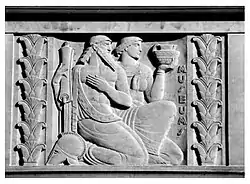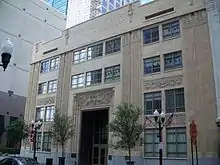Greco Deco
Greco Deco is a term coined by Washington, DC based art historian James M. Goode to describe a style of art and architecture popularized in the late 1920s and 1930s.[1] Arising out of the Beaux-Arts tradition, Greco Deco combined Greek and Roman traditions with those of the then fashionable Art Deco. The style is also referred to as Stripped Classical for its simpler appearance compared to neoclassical architecture.[2]


Greco Deco architecture frequently expressed itself in a rather severe Greco-Roman facade decorated with deco styles shallow reliefs and/or deco styled interior decoration featuring murals, tile mosaics and sculpture. A common motif among Greco Deco architecture is the use of stylized or simplified pilasters. The style was the almost-official style of many federal and local government buildings in the United States from the mid-1920s until World War II, and frequently overlaps with the style that architectural historian David Gebhard terms "WPA Moderne."
Architects
Sculptors
References
- James M. Goode (1 December 1981). Capital Losses: A Cultural History of Washington's Destroyed Buildings. Smithsonian Institution Press. pp. 178, 188. ISBN 978-0-87474-479-8. Retrieved 5 April 2013.
- http://www.gsa.gov/portal/ext/html/site/hb/category/25431/actionParameter/exploreByBuilding/buildingId/829
